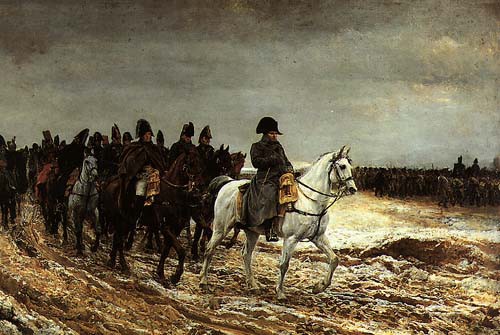The Musée d'Orsay collection ranges from 1848 to 1914 and thus displays important pieces from the Second Empire (1852-1870. In keeping with its original aim, its ambition is to present all of the artistic diversity of the period through various types of artistic objects: paintings, sculptures, architectural projects and ornamentation are combined in every room in order to make the links between them apparent.
The Second Empire collections are spread out on the museum's first floor which is devoted to the 1848-1875 interval. The main aisle is devoted to sculpture and starts off with an evocation of the Romantic movement and Rude. His “Napoleon Awaking to Immortality” was commissioned by an admirer of the late Emperor, Captain Noisot, who had the bronze sculpture erected on the grounds of his estate in Fixin. The Second Empire consecrated this somewhat declining artistic movement thanks to a series of commissioned works and State purchases. The sculpture by Barye representing Napoleon as a Roman soldier illustrates the neoclassical style expressed by Cavelier all through the Empire. Other artists were inspired by styles of the past. For example, a group of young sculptors called the “Florentines” turned towards the Renaissance. Orientalism also gradually made a name for itself: the taste for polychromatic exotic objects and realism mingled thus bearing witness to the artistic tastes of the period (negro busts by Ordier).
Another style in sculpture is illustrated by Carpeaux. He broke away from the academic style of the period and developped a very expressive kind of realism which the imperial court admired greatly. Although he was not the official portrait-painter of the court at the time, he drew a number of very vivid sketches of Napoleon III and his wife, and produced a few busts. He was commissioned to make a full-length statue of the Imperial Prince with his dog, Nero, by his side. He also took part in the decoration of many buidings of the Second Empire: the Flore pavilion in the Louvre, the “Dance” in the Opera-House, a frenzied freize which provoked a scandal when it was unveiled in 1869.
On the left hand side of the main aisle, visitors can admire early impressionist paintings and on the right hand side, the inheritance of the romantic and the neoclassical styles owing to a few late works by Delacroix and Ingres. Eclecticism and Symbolism complete the visit. Far too many masterpieces are featured in this part of the museum for us to quote all of them. Let us merely evoke a few aspects of the various major artistic styles.
Painting, like sculpture, produced a great many different styles: academic, realist, naturalistic, and oriental styles were all triumphant successes during the various exhibitions and World Fairs and defined the artistic life of the Second Empire. Paintings by Baudry, Bouguereau, Breton, Cabanel, Delaunay, Gérôme, Hébert, Belly, Fromentin and Guillaumet were particularly appreciated by the new bourgeoisie even if they never became as successful as paintings by Meissonier.
Contrary to these official artists, others created artistic disturbances: Millet, Courbet, whose “Funeral in Ornans” and “Artist's Studio” were both turned down at the World Fair in 1855, and, above all, Manet. His piece,”Le Déjeuner sur l'Herbe” made the headlines at the infamous Salon des Refusés in 1863 while “Olympia” received an outburst of hate from the critics and the public in 1865.
The Barbizon school and painting in open-air are magnificently represented at the Musée d'Orsay andboth grew in stature during the Second Empire: paintings by Corot and Rousseau were purchased by the State and Boudin successfully exhibited his small studies of the beach in Deauville and Trouville. Early impressionist painting met however with the public's lack of understanding even if certain paintings were accepted at the Salon (such as “Family Reunion” by Bazille).
Musée d’Orsay


